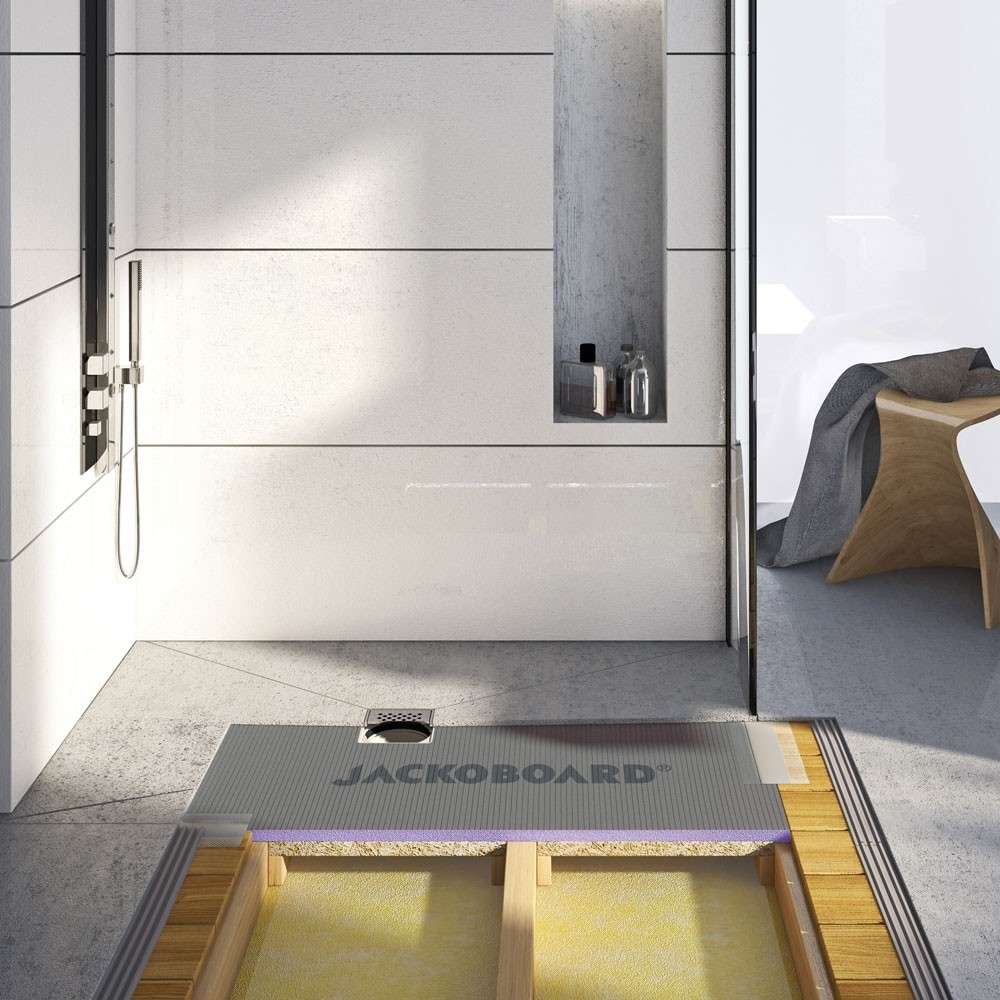If you’re creating a wet room in your home, Jackoboard is a name you need to know. They offer the perfect waterproofing solution for your luxurious new bathroom space! Below, we answer all your Jackoboard related questions…

What is Jackoboard?
Made from an extruded polystyrene foam, JACKOBOARD® Plano construction boards are water-repellent and easy to work with. Finished on both sides with a special coating, they are ready to be tiled, rendered or plastered. Their excellent thermal insulation properties make them ideal for use as effective thermal insulation. The construction boards are perfectly suited for interior construction and furnishings – especially in rooms subject to high moisture levels.
Why use Jackoboard?
As a replacement for other general substrates such as plywood, plasterboard or plaster. Jackoboard is lightweight, thicknesses from 4mm – 80mm in 1200mm x 60mm and 2400mm x 60mm size formats. Can be installed in rooms where high moisture levels are expected. The board also has excellent thermal properties and high compressive strength. All Jackoboard Plano boards are BBA Certified.
How does Jackoboard compare to other substrates?
Unlike plasterboard, plywood and other wood type boards, Jackoboard plano is water repellent. Therefore, any water penetration from the finished surface will not penetrate through to the structural elements of the building. Equally, areas where moisture may penetrate from the outside can be minimised by installing the Jackoboard Plano.
Can Jackoboard be used on walls and floors?
Yes, however, it is important to know the structure onto which the Jackoboard is to be installed. This will then enable you to determine which board is best for your specific installation.
Wall installation
When fixing to walls on a timber stud frame: if the frame is built with 300mm centres a 10/12mm board can be fixed. Where the stud frame is greater than this a 20mm board is recommended.
Fixing to an uneven brickwork/blockwork wall a 20mm board is recommended. On a flat and solid wall, a minimum of 10mm board can be installed.
Floor installation
The Jackoboard can be installed as an overboard onto both cement and timber-based substrates. In all cases the thicker the board the greater the insulation properties. However, where height is an issue a minimum of 6mm board can be used when installed according to Jackon UK Ltd guidelines and Codes of Practise.
What surface finish can be applied to the Jackoboard?
Due to its component construction, it is recommended to apply ceramic, porcelain, stone or equivalent type tiles to the boards’ wall and floor.
What type of adhesive should be used?
When installing the boards and subsequently applying tile to the boards it is recommended to use a cement based single part flexible adhesive. When fixing tiles to the boards there is no need to prime the board first.
Is Jackoboard suitable for Wet Areas?
Jackoboard is specifically manufactured to perform in modern bathroom and wet room environments. The board is BBA certified and conforms to the standards and codes of practice set out in BS5385 for tiling in wet areas and as an alternative to plywood.
Do I need to apply tanking (waterproof membrane) to Jackoboard?
As Jackoboard is water repellent there is no need to apply any proprietary tanking solution to the board. However, to make a room completely waterproof a tanking solution should be applied to all joints and vulnerable points. (Where the board has been mechanically fixed).
Can I use underfloor heating with Jackoboard?
One of the key properties of Jackoboard is its thermal insulation. Therefore, it is an ideal product to use when installing electric underfloor heating mats on tiled floors.
Does Jackoboard require priming prior to tiling?
Due to the surface coating of the board, priming is not required when using a cementitious flexible adhesive.
Is it necessary to make the joints between boards waterproof?
There are a variety of methods to ensure the joints are waterproof. Apply a waterproof tanking membrane to the joints in conjunction with the non-self adhesive sealing tape. Using the Jackoboard Board Fix join the boards together. Apply the self-adhesive tape and commence tiling.
Can Jackoboard be used in Kitchens and Fireplaces?
As Jackoboard has a polystyrene core it is not recommended to use in areas where direct heat will affect its performance. Therefore, it is not suitable for use behind or next to ovens or in fireplaces or fireplace surrounds or areas where the temperature exceeds 75ºC.
Will Jackoboard span floor joists?
Jackoboard Plano and Shower trays are not self supporting. Therefore are not suitable as an alternative to floorboards. However, where there is a problem substrate or the floor requires strengthening, Plano can be used.
Are Jackoboard shower elements compatible with vinyl?
Unfortunately, no. The drain does not have a clamp facility therefore the joint around the drain is open to water ingress. The shower trays whilst very strong will over time become indented with foot traffic and in extreme circumstances wheelchair access. Finally, should the tray surface be damaged there is a risk that the adhesives used to adhere vinyl may have an adverse effect on the performance of the polystyrene.
Can the Jackoboard Shower Elements be cut?
Yes the shower elements can be trimmed to suit. However, please note that where trimming is required, this must be done equally from both sides of the tray. E.g. making a 1200 x 900 tray 1100 x 900, cut 50mm of each side of the 1200 side to meet the 1100 x 900 size format. It’s also recommended that where the tray has 4 falls the distance from drain edge to the tray edge is no less than 175mm.
Be sure to tag us in pictures of your DIY projects on Instagram, @Wallsandfloors, we love seeing what you’ve been up to!





